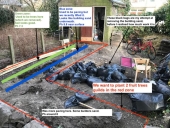Hi all,
I'm working on my new garden - you can see my main thread here:
https://permies.com/t/154597/Garden-Scratch-ADVICE
My questions today are about soil. I've started trying to test the soil as I want to prepare for planting a forest-ish garden in the autumn (The 'ish' is because i don't have a big enough garden for a lot of trees). I bought a ph soil testing kit and tested from 6 different places around my garden. One place was ph7, one was about ph7.25 and the other four seemed strongly ph7.5 (but the kit only seems to test up to ph7.5 anyway, so perhaps the soil is more alkaline than that?).
I've also doen the jar test whereby you put some soil in a jar and shake with water and let it settle to get an idea of soild structure. You're supposed to let it settle for 24hrs - it's only been 12 hours so far, but initial results suggest that my soil will definitely be on the clay side.
I'm not really sure why my soil would be alkaline. It sould be underlying rock, but I didn't think there was alkaline rock under my town (I live in Hastings, England) - although there is in other parts of the county. Is it possible that builders have contaminated the soil with cement and building rubble? The soil is quite stoney in some places and I've seen plenty of red brick fragments. One end of my garden also has a fairly new area of cement, so perhaps the remnants was dumped onto the soil when that area was created. One area that I tested was neutral, so is it possible that my soil is naturally closer to that and I just need to use maintenance to bring all of the soil back to that?
I want to grow fruit trees and bushes, would a soil of ph7-7.5 be a big problem, or would a higher level of alkalinity be needed to negatively affect fruit plants? I know that some specied like blueberries are particularly fond of acid soil, but are the others more tolerant?
Finally, I'm a bit confused by my jar test showing a clay soil because when I was digging for soil samples, the soil seemed generally very dry - almost dusty in some parts. I thought a clay soil would be more dense and compacted? Having said that, it has been a unusually dry start to the spring, so maybe it's simply that.
In a nut shell... I'm not sure if I should trust my testing or what I should do next in terms of treating/maintaining the soil. I think the garden has been neglected generally for years before i bought it, so perhaps it just needs some standard TLC to bring it into a condition that most plant species will tolerate, or do you think that I should pay careful attention to the alkalinity readings of my soil testing? I'm less concerned about the soil being clay-based as I think I know how to deal with that.
At the moment, I'm starting to sheet-mulch the grass (which covers the whole garden) with cardboard - I should have the whole garden covered in a couple of weeks. After six months I'm hoping that the soil underneath the cardboard will be more friable and I'll be able to dig the whole garden to ease compaction (after this I will revert to no-till). And then in the autumn I would like to do as much planting as possible.
Lastly, the patch of long grass in the photo is where I hope to put a pond, but I haven't completely made up my mind about the pond location yet.
All advice very welcome!





















 2
2




 4
4














 1
1





 2
2









 2
2















